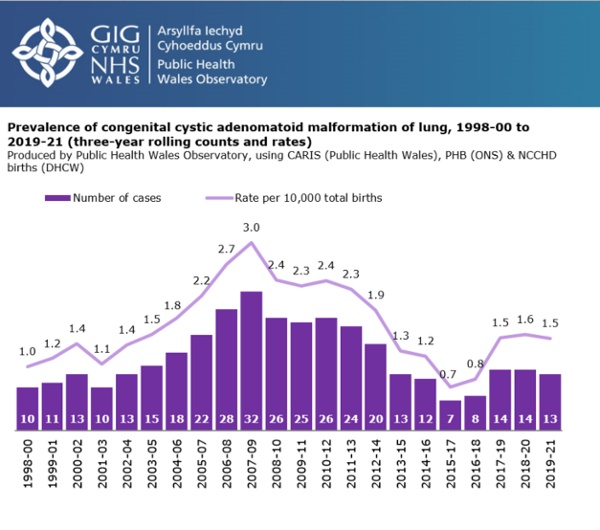Respiratory System
Congenital Cystic Adenomatoid Malformation of the Lung (CCAM)
What is it?
CCAM occurs when part of the lung is replaced by a non working cyst of abnormal lung tissue.
Embryology
This is unknown but thought to be due to local bronchial atresia or bronchial occlusion.
Causes and risk factors
None known.
Detection
CCAM can be detected antenatally with ultrasound. CARIS data shows that the detection rate is approximately 85 per cent.
Patterns and trends
Within Wales
112 cases have been reported to CARIS (1998-2016) giving a gross prevalence rate of 1.8 per 10,000 total births. Recent EUROCAT analysis has suggested a general rise in Wales in the past decade. The reasons for this are not clear but may be associated with improved methods of antenatal detection.

Wales compared to elsewhere
The EUROCAT mean rate is somewhat lower at 0.7 per 10,000 total births.
Management and outcome
In most cases the outcome is very good with some resolving in pregnancy. Postnatal investigation is important for assessment and possible removal because of the risk of malignancy, although clinical opinion is divided on the best treatment option. An audit of cases in 2009 in Wales suggest that eight of forty eight cases might have been lost to follow up after birth [1].
Sources
-
Textbook of Fetal Abnormalities 2nd edition, 2007 Twining, McHugo, Pilling Churchill Livingstone
Reference
[1] Outcome of antenatally suspected congenital cystic adenomatoid malformation of the lungs (CCAM) and sequestration of the lungs in Wales, UK: 7 years experience 2000-2006, Gopalkrishnan, Calvert, Morris, Doull and Tucker, ICBDSR annual meeting, Salt Lake City, USA, 2009